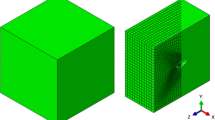Abstract
Ingots from casting processes usually contain defects such as voids from solidification. These voids can lead to failure during application, e.g., crack formation. Accordingly, it is important to close these voids in the forging process. Predicting the closure and healing of voids during forging has been the subject of numerous studies, most of which assume a constant loading direction. As multiple-pass open-die forging processes usually include workpiece rotations, in this study, an existing criterion found in the literature for the prediction of void closure is extended to consider changing loading directions. For model validation, an AISI 4140 ingot with artificial voids is forged, and the void volume is investigated by radiographic analysis. The results confirm the improvement in the model prediction provided by the proposed extension.








Similar content being viewed by others
References
Campbell J (2015) Complete casting handbook, 2nd edn. Butterworth-Heinemann, London, pp 516–529
Park CY, Yang DY (1996) A study of void crushing in large forgings—I: bonding mechanism and estimation model for bonding efficiency. J Mater Process Technol 57:129–140
Saby et al (2015) Void closure criteria for hot metal forming: a review. J Manuf Process 19:239–250
Kakimoto H et al (2010) Development of forging process design to close internal voids. Int J Mater Process Technol 210:415–422
Kim PH et al (2002) Pass schedule algorithms for hot open die forging. Int J Mater Process Technol 130–131:516–523
Chen K et al (2010) Simulation of void defect evolvement during the forging of steel ingot. Adv Mater Res 97–101:3079–3084
Zhang X-X et al (2009) A criterion for void closure in large ingots during hot forging. J Mater Process Technol 209:1950–1959
Stahlberg U et al (1980) A study of void closure during plastic deformation. J Mech Work Technol 4:51–63
Dudra SP, Im Y-T (1990) Analysis of void closure in open-die forging. Int J Mach Tools Manuf 30(1):65–75
Saby M et al (2015) A geometry-dependent model for void closure in hot metal forming. Finite Elem Anal Des 105:63–78
Chbihi A, Bouchard P-O, Bernacki M, Pino Munoz D (2017) Influence of Lode angle on modelling of void closure in hot metal forming processes. Finite Elem Anal Des 126:13–25
Spittel M, Spittel T (2009) Materials: metal forming data of ferrous alloys—deformation behavior, Landolt Börnstein, group VII advanced materials and technologies 2C1: AISI 4140 715-718. Springer, Berlin
Acknowledgements
The author would like to thank the Deutsche Forschungsgemeinschaft DFG for the support of these works within the project HI790/53-1 (Project number: 283878720) “Kriterien zum Verschließen und Verschweißen von Poren beim Freiformschmieden“.
Author information
Authors and Affiliations
Corresponding author
Ethics declarations
Conflict of interest
The authors declare that they have no conflict of interest.
Additional information
Publisher's Note
Springer Nature remains neutral with regard to jurisdictional claims in published maps and institutional affiliations.
Rights and permissions
About this article
Cite this article
Hibbe, P., Wolfgarten, M. & Hirt, G. Investigation of void closure in open-die forging considering changing load directions. Prod. Eng. Res. Devel. 13, 703–711 (2019). https://doi.org/10.1007/s11740-019-00924-0
Received:
Accepted:
Published:
Issue Date:
DOI: https://doi.org/10.1007/s11740-019-00924-0




